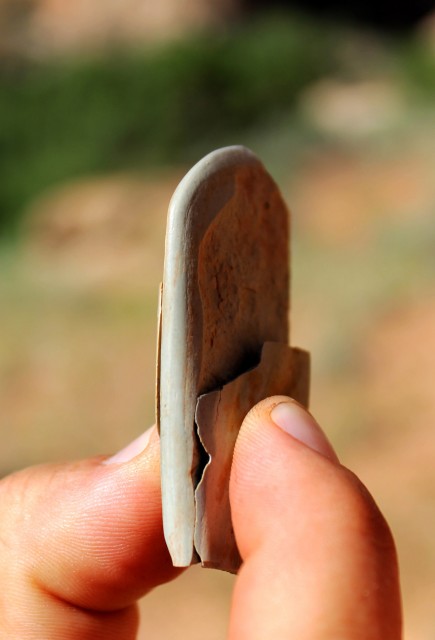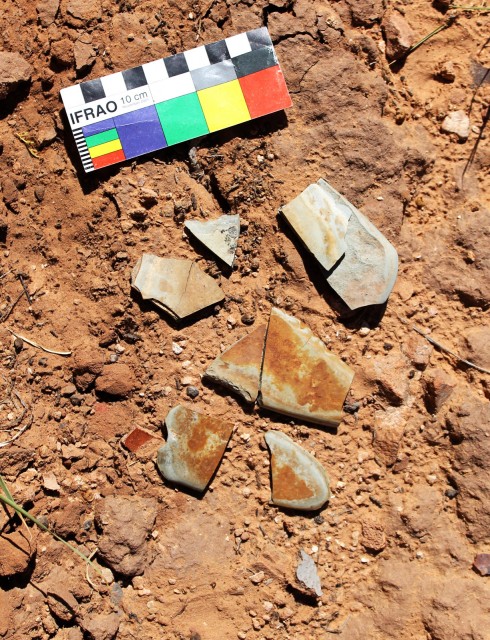- Home
- >
- Preservation Archaeology Blog
- >
- Piecing History Back Together: A Lesson from the P...
(September 13, 2016)—Cultural affiliation studies are particularly important tools that Native peoples, anthropologists, and archaeologists use to demonstrate tangible links between people of the ancient past and contemporary societies. These studies are especially significant in the politically charged events presently surrounding the push to designate a national monument around the Bears Ears area in southeastern Utah. The story I share here shows that even a single artifact can play a significant role in piecing together the history of Ancestral Pueblo peoples—and that taking or moving even one artifact may have far deeper and lasting ramifications for the future of public lands across the Southwest.
My story begins last summer, during a fieldwork session in a remote gulch in southeastern Utah. I was conducting a survey of Ancestral Pueblo cliff dwellings for my dissertation research. My intrepid crew of volunteers and I had been backpacking through one of the more famous and well-trodden canyon systems in the region for several days when we unexpectedly came upon a highly significant artifact (well, a set of them, actually) sitting on the surface of a midden (trash deposit) at a rather unassuming-looking site.
As I visually scanned the midden, taking notes on the types of gray, black-on-white, and black-on-red potsherds, several of the fragmented pieces of this flaked and ground stone tool came into view. I knew what it was right away—it was a tchamahia.
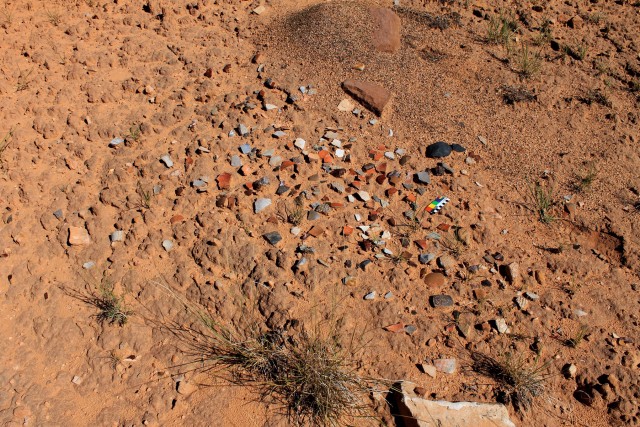
Tchamahias are finely flaked and ground celt-like, or axe-shaped, artifacts that probably functioned as “ceremonial hoes” and altarpieces. They have only rarely been recovered from archaeological sites in the Four Corners region. When they are found, they are studied with great interest because of their implications for investigations of Ancestral Pueblo origins and migrations.
People made tchamahias during the Pueblo II and III periods (A.D. 950–1300) in southeastern Utah and southwestern Colorado. Examples from Utah are made almost exclusively from a light blue-green stone called Brushy Basin Chert (BBC). Now, tchamahia is a word from the Keres language, one of the four major languages spoken by Pueblo peoples living in the northern Southwest. In the 1960s, noted anthropologist and archaeologist Florence Hawley Ellis worked with Keres-speaking peoples and documented how they associated these artifacts with the Old Stone people, ancestral beings who instructed and guided the ancestors of the Keresan peoples to their homes at Acoma, Laguna, Zia, Santa Ana, Cochiti, Santo Domingo, and San Felipe during their long and segmented migrations.
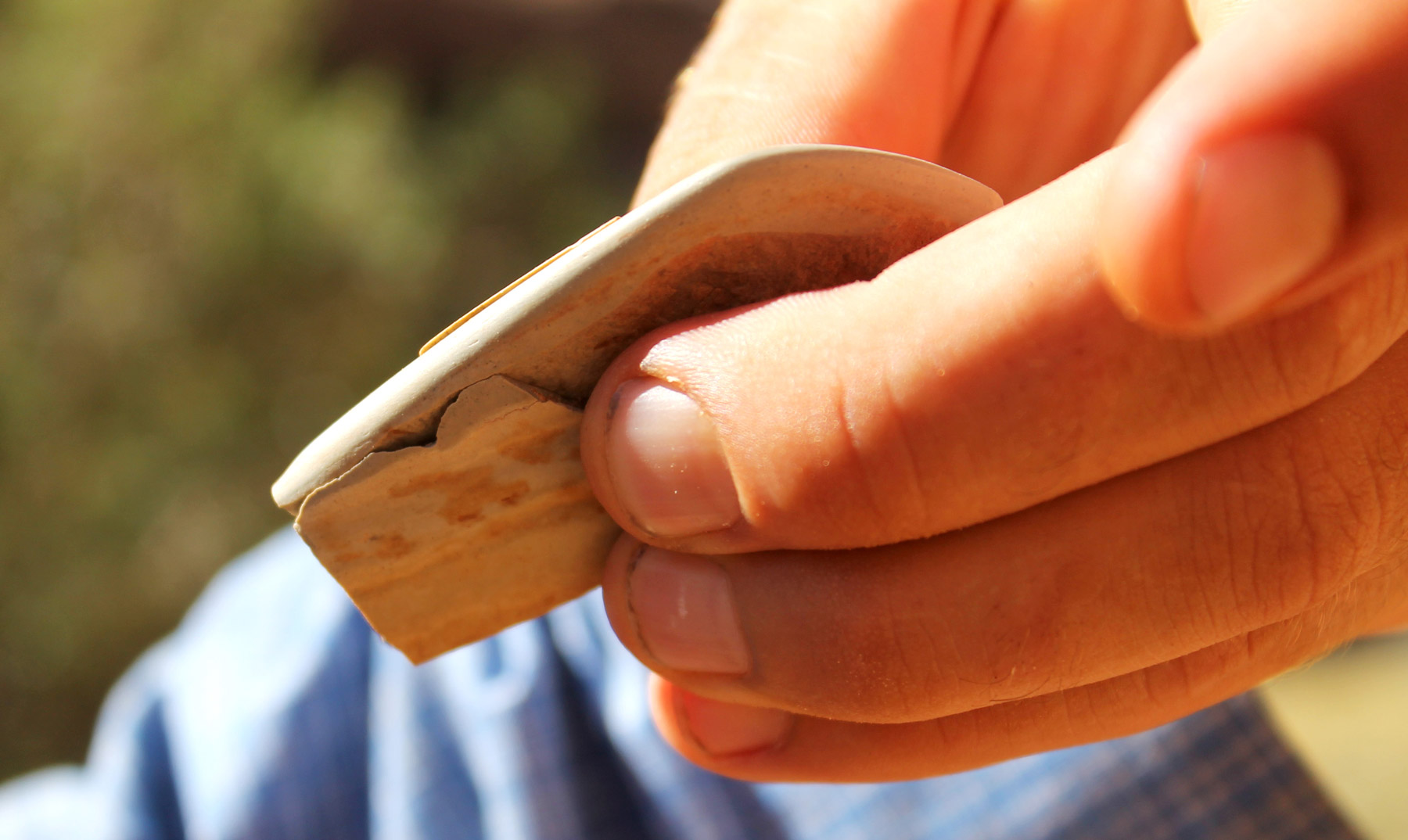
Early ethnographer and archaeologist Jesse Walter Fewkes found that clans and societies at Hopi also used tchamahias in special contexts, and people said that the tchamahias they possessed were made long ago by their ancestors who lived in the Four Corners area. Indeed, Keres and Hopi stories suggest that these tools were important badges of office and objects of memory for some groups of their ancestral clans since before their migrations out of the Four Corners area at the end of the 1200s. No similar claims about these tools have been made by other Pueblo clans or by other Native peoples in the region.
These historical insights from Pueblo peoples suggest two important points. First, that tchamahias can serve as a material indicator of the movement and distribution of some clans that were ancestral to the modern Keres and Hopi peoples, prior to 1300. Second, that the presence of tchamahias in the archaeological record might be drastically underrepresented (essentially missing), because when people left long ago they took most of the usable ones with them. A situation that makes them even rarer in the archaeological record.
The Brushy Basin Chert (BBC) material from which people made tchamahias is found only in areas of the Four Corners where a massive geologic layer called the Morrison Formation is exposed, primarily near the San Juan River upstream of the Goosenecks in Utah and Arizona. The few archaeological studies that have looked at them in detail suggest that people initially flaked (flintknapped) raw tabular pieces of BBC into rough form near outcrops of BBC. After this rough shaping, people probably took these blanks back to their villages; archaeologists haven’t found finished tools at these quarries or flaking stations.
Makers finished the raw forms by grinding their surfaces down with sandstone, on surfaces that were probably like the grinding slicks and sharpening grooves found on numerous boulder and cliff surfaces near cliff dwellings in the canyons of the area. People hafted the finished objects onto the ends of smoothed sticks or handles. Archaeologists think that these hafted tools might have functioned as badges of office, ceremonial planting sticks, or altarpieces.
Our mandate on our archaeological survey is “take only photographs, leave only footprints,” and we even try to leave no tracks. So, I picked up the pieces as gingerly as possible, remembering where they originated and knowing I would have to put them back exactly where they came from. I sat there for a few minutes looking at the pieces and gently trying to put them back together. To my surprise, I was able to fit most of fragments of the tool back together from where they broke along the weakly bonded natural fissures in the parent material. Even more surprising was that most of the tool was there, just sitting on the midden surface, although in several pieces.
Middens are parts of a site where Ancestral Pueblo peoples threw their trash and sometimes buried their dead, and their presence usually indicates that a particular site was a place where people lived. This is where residents threw away broken pots and stone tools, organic material (i.e., human waste), and everything else unwanted. Archaeologists really like middens because they tell us a lot about ancient life at these sites. For example, if we find pieces of a broken pot or pots (hopefully a lot of them) that we know date between A.D. 1000 and 1075, we also know that someone used and broke a pot there sometime during that 75-year period. The more evidence we have from different types of potsherds and other artifacts in a midden, the clearer the picture becomes. Conversely, if people have taken some or most of these artifacts in more recent times, little or none of the picture might remain to be pieced back together.
Getting back to my story, this particular midden with the tchamahia fragments was relatively undisturbed, a rare occurrence these days in the canyons of the Bears Ears area. It contained thousands of sherds and discarded stone tool fragments, and there were no visible looter holes. Most of these sherds came from vessels of three types: Deadman’s Black-on-red, Mancos Black-on-white, and Mancos Corrugated Gray. All these types were used in southeastern Utah, primarily during the period between about 1000 and 1075. Very few pottery types dating after about 1075 were found on the midden surface, and this tells us that the site and the tchamahia both probably date to this same period of time.
So, why does it matter when this one artifact probably dates to? Why does any of this old junk at a remote site in the desolation of an unknown canyon in Utah even matter at all? Well, the answer is simple and complex.
First, it is only because the site is relativity undisturbed that we can even link this rare artifact (most of it, anyway) with a particular time period and context of use. We can verify, from just survey results, that tchamahias are associated with this part of the Pueblo II period in southeastern Utah. If the site had been visited by many people, it is likely that there would be far fewer artifacts left on the surface, as many modern hikers feel the need to pile up the artifacts or take them home as souvenirs. They don’t realize that taking or moving even one artifact out of its archaeological context removes these pieces from the puzzle—that their thoughtless act takes an artifact out of this picture forever.
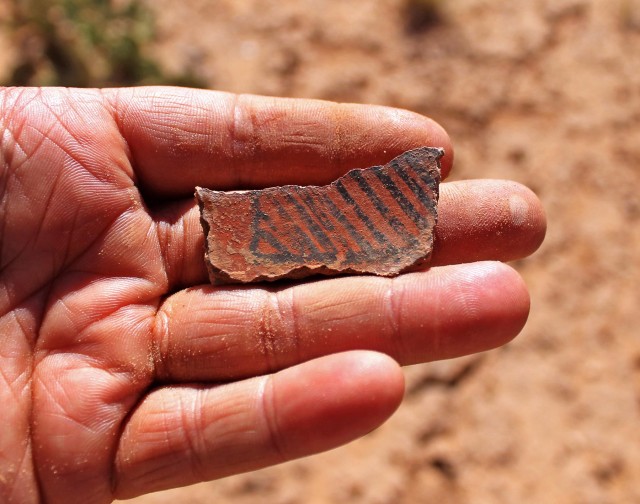
More importantly, though, because of the continued significance of tchamahias to clans and groups ancestral to contemporary Keres and Hopi peoples, we can tie this site into the larger story—the history—of these groups. By piecing this and similar types of stories back together, we can reconnect the link between Four Corners peoples of the past and present. Through such studies, we can verify at least parts of the origin stories of Native peoples and their claims to ancestral lands.
Full-blown cultural affiliation studies, far more detailed and well-cited than what I have presented here, are used by today’s Native tribes to establish or build claims to their ancestral homelands. In the case of this particular tchamahia, it is only because the midden at this site had remained undisturbed that the fragments of this artifact were there to be found by someone who understood their significance, the important story they could tell, and the claims to ancestral lands that they could support. Only within such an unbroken archaeological context may we fully comprehend the significance of this or any other artifact.
The lesson is that every artifact matters, every site matters, every canyon in the ancient social landscape in the greater Bears Ears area matters. Imagine how the story would have been different and incomplete if I had put the fragments of this tchamahia into my pocket. Instead, I took each piece and put it back in the spot where I had found it, reconnecting the past with the present, ensuring that the links between ancient people living in the Bears Ears with at least some of their descendants would endure, perhaps for another thousand years. I hope you do the same.
Ben Bellorado is a PhD Candidate in the School of Anthropology at the University of Arizona. He enjoys backpacking and camping in remote parts of the American West, photography, spending time with friends and family, and whitewater rafting.
